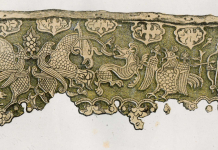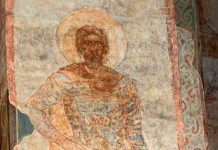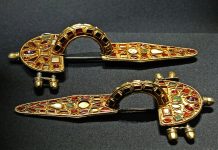Ibn al-Nadim (died 995) was an important Muslim bibliographer and biographer of Baghdad who compiled the encyclopedia Kitāb al-Fihrist (The Book Catalogue). His work contains an interesting passage on the Rus in a part of the book devoted to the scripts employed by various peoples: “A man whose word I trust told me that one of the kings of Mount al-Qabq (the Caucasus) sent him to the king of Rus. He believes that they have writing inscribed on wood, and he showed me a piece of white wood with an inscription on it. The following is an example, but I do not know whether these are words or single letters.” (see title image)
Simon Franklin mentions this inscription in his Writing, Society and Culture in Early Rus, c. 950–1300: “The characters, as transmitted in manuscripts of al-Nadim, resemble neither Cyrillic nor (the next obvious assumption) Scandinavian runes. It would be safest to suppose that, if al-Nadim’s tale was true, the specimen signs were originally Cyrillic or runic but have been distorted beyond reasonable recognition by uncomprehending copyists. Bolder spirits, however, prefer the reverse procedure: which known script or scripts, however remote from the known scripts of the Rus, resemble al-Nadim’s surviving transcription? This way, more exciting solutions emerge. An early commentator found remarkable similarity with characters from undeciphered inscriptions from Sinai, though he draws back from asserting any real connection. A recent investigator has perceived in al-Nadim’s characters an affinity with ancient Indian Brahmi syllabic script, and with the aid of Brahmi he manages to decode the message as Slavonic. (S. Franklin, Writing, Society and Culture in Early Rus, c. 950–1300 (Cambridge: Cambridge University Press, 2002).
One wonders why did the ‘bolder spirits’ who ‘found remarkable similarity with the inscriptions at Sinai’ not explore a possible similarity with the Phoenician Alphabet?
“Gardariki, Ukraine” e-book makes a claim of the Rus’ origin which seems to explain a lot of unanswered questions like the one about the script.










